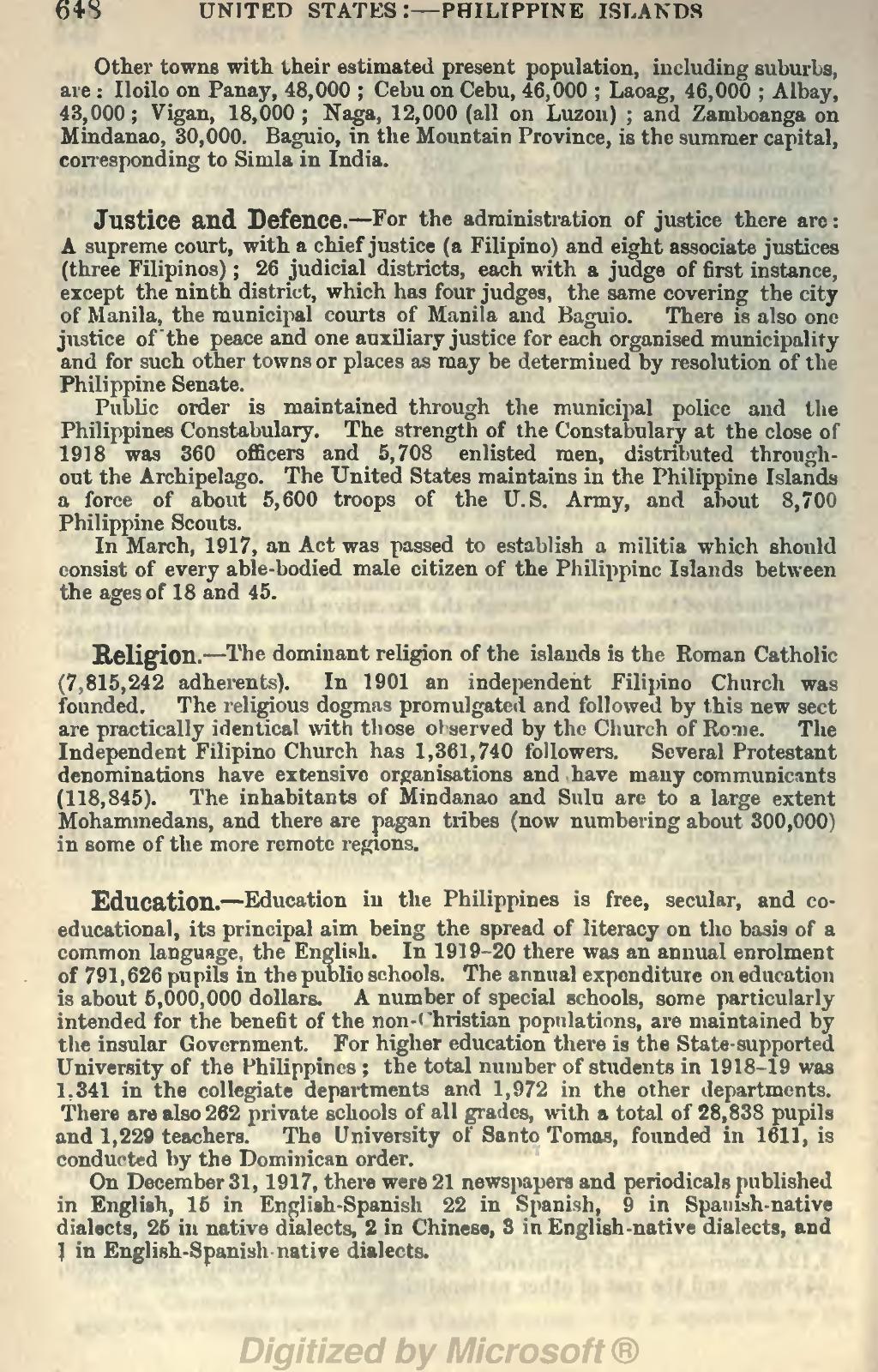6 + 8 UNITED STATES: — PHILIPPINE ISLANDS
Other towns with their estimated present population, including suburbs, are : Iloilo on Panay, 48,000 ; Cebu on Cebu, 46,000 ; Laoag, 46,000 ; Albay, 43,000; Vigan, 18,000 ; Naga, 12,000 (all on Luzon) ; and Zamboanga on Mindanao, 30,000. Baguio, in the Mountain Province, is the summer capital, corresponding to Simla in India.
Justice and Defence. — For the administration of justice there are : A supreme court, with a chief justice (a Filipino) and eight associate justices (three Filipinos) ; 26 judicial districts, each with a judge of first instance, except the ninth district, which has four judges, the same covering the city of Manila, the municipal courts of Manila and Baguio. There is also one justice of "the peace and one auxiliary justice for each organised municipality and for such other towns or places as may be determined by resolution of the Philippine Senate.
Public order is maintained through the municipal police and the Philippines Constabulary. The strength of the Constabulary at the close of 1918 was 360 officers and 5,708 enlisted men, distributed through- out the Archipelago. The United States maintains in the Philippine Islands a force of about 5,600 troops of the U.S. Army, and about 8,700 Philippine Scouts.
In March, 1917, an Act was passed to establish a militia which should consist of every able-bodied male citizen of the Philippine Islands between the ages of 18 and 45.
Religion. — The dominant religion of the islands is the Roman Catholic (7,815,242 adherents). In 1901 an independent Filipino Church was founded. The religious dogmas promulgated and followed by this new sect are practically identical with those observed by the Church of Rome. The Independent Filipino Church has 1,361,740 followers. Several Protestant denominations have extensive organisations and have many communicants (118,845). The inhabitants of Mindanao and Sulu arc to a large extent Mohammedans, and there are pagan tribes (now numbering about 300,000) in some of the more remote regions.
Education. — Education in the Philippines is free, secular, and co- educational, its principal aim being the spread of literacy on the basis of a common language, the English. In 1919-20 there was an annual enrolment of 791,626 pupils in the public schools. The annual expenditure on education is about 5,000,000 dollars. A number of special schools, some particularly intended for the benefit of the non- christian populations, are maintained by the insular Government. For higher education there is the State-supported University of the Philippines ; the total number of students in 1918-19 was 1,341 in the collegiate departments and 1,972 in the other departments. There are also 262 private schools of all grades, with a total of 28,838 pupils and 1,229 teachers. Tho University of Santo Tomas, founded in 1611, is conducted by the Dominican order.
On December 31, 1917, there were 21 newspapers and periodicals published in English, 15 in English-Spanish 22 in Spanish, 9 in Spanish-native dialects, 25 in native dialects, 2 in Chinese, 3 in English-native dialects, and 1 in English-Spanish native dialects.
